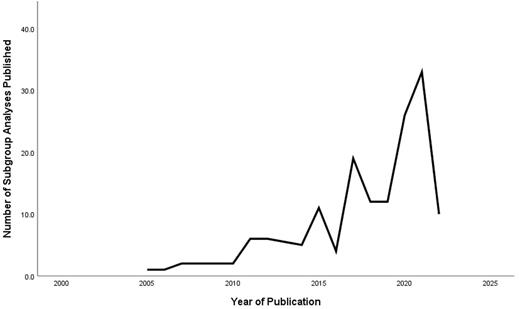Abstract
BACKGROUND
The use of subgroup analysis in clinical trials is expanding. Subgroup analysis is usually used to explore the consistency or heterogenicity of the treatment effect across different groups. Useful information from subgroup analyses within a randomized clinical trial is restricted by multiplicity of testing and low statistical power. There is a concern that subgroup analysis is used more frequently in hematological malignancies. Our study aims to analyze the extent of use of subgroup analyses in hematological malignancies and characterize associations with specific cancers and/or funding sources.
METHODS
We conducted a systematic database search of Medline, PubMed, and Scopus to identify publications reporting subgroup analyses of cancer-related studies. We included all subgroup analyses of interventional cancer clinical trials that were published between 2000 and 15th of February 2022. We collected data on clinical trial, studied cancer, funding, subsequent publication including journals, funding source, use of medical writing and authorship characteristics. Statistical analysis was done using SPSS Statistics.
RESULTS
A total of 154 publications of subgroup analyses in hematological malignancies were found. Most common hematological malignancies of which subgroup analyses was used were multiple myeloma (MM) (32.7%), non-Hodgkin lymphoma (22.8%) and acute myeloid leukemia (12.7%). Subgroup analyses publications were distributed in 71 journals with a range of publications per journal of 1- 13. The journals with the most frequent subgroup analyses publications were Leukemia (n=13), Hematologica (n=12) and Leukemia and Lymphoma (n=11). Median impact factor (based on year 2016) of journals that published subgroup analyses was 4.93 (IQR: 5.20). Medical writing was used in 46% (n=71) with pharma funding reported in 71% (n=109) of publications. Most common funding companies of subgroup analyses were Amgen (13.9%), Janssen (9.7%) and Celgene (7.3%). The median number of authors was 14 (IQR: 9). Men were more likely to be first authors (67.9%), last author (73.9%) and corresponding author (67.3%). A total of 76% of authors disclosed conflicts of interest related to the subgroup analysis published. Subgroup analysis was mentioned in the title of publication only in 53.3% of the publications with the rest of publications reported the use of subgroup analysis in the abstract and/or methods. A trend analyses showed increased use of subgroup analysis in more recent years (45% in 2020-2022 vs. 24.7% in 2000-2015 and 30.5% in 2016-2019). [Figure.1] The use of medical writers is increasing with the highest usage reported in 2020-2022 (P-value: 0.036).
CONCLUSION
There is an increased use of subgroup analysis in hematological malignancies. Most authors of subgroup analysis reported conflict of interest related to the study and the published subgroup analysis. Subgroup analyses are frequently published in journals with high impact factor, supported by pharmaceutical companies and higher use of medical writers. Efforts should be made to limit the use and/or publication of subgroup analysis given its limitations.
Disclosures
No relevant conflicts of interest to declare.
Author notes
Asterisk with author names denotes non-ASH members.


This feature is available to Subscribers Only
Sign In or Create an Account Close Modal